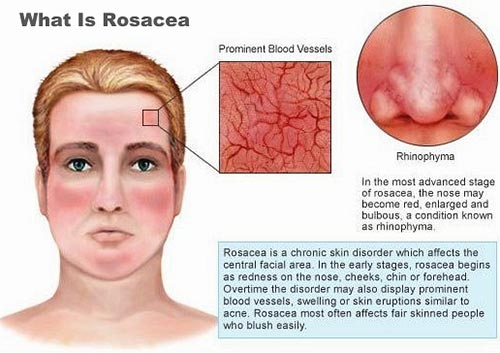Rosacea

A chronic yet routine skin condition in people over the age of 30, rosacea generally manifests itself as the extreme visibility of red blood vessels in your cheeks, nose, and forehead. It often appears in flare-ups lasting for several weeks or even months, only to then temporarily disappear into remission. Unless you have it treated, it will continue to recur.
The disease can sometimes lead to a swelling of your nose known as rhinophyma. For many patients, watery and bloodshot eyes due to ocular rosacea are another unfortunate result and can lead to both burning and soreness.
In certain cases, New York City dermatologists have noticed that if you leave it untreated, the disease can evolve into pus-filled bumps. These small facial pimples can be confused with acne or an allergic reaction. You should always consult a professional dermatologist if you notice these and other symptoms of rosacea.
The Symptoms of Rosacea
Dermatology offices in New York encounter cases of rosacea in both men and women and on both light and dark complexions. The common symptoms include:
- Facial redness or flushing: Regardless of your skin tone, the erythematotelangiectatic rosacea usually results in a persistent redness or transient flushing in the middle of your face. It’s the result of inflammation in the numerous blood vessels on your skin’s surface.
- Pimple-like bumps: With papulopustular rosacea, small pus-filled bumps may appear on your face. They resemble acne, but your skin may feel hot and flushed.
- Eye irritations: About 50 percent of rosacea patients also experience ocular rosacea resulting in eye irritation such as dry, bloodshot eyes, swelling, and inflammation of your eyelids (blepharitis), and a sensation of a foreign substance on your eyeball. It can lead to ulcerations on the cornea (keratitis), which can lead to light sensitivity (photophobia), eye pain, and poor vision. The discomfort in your eyes may even precede the telltale symptoms on your skin. If left untreated, it can lead to permanent vision loss.
- Rhinophyma: This condition simply refers to the enlargement of your nose that can occur with phymatous rosacea. Though rare, the oil or sebaceous glands in your nose, chin, or cheeks may swell up in severe cases. This particular symptom is generally more common in males than females.
Rosacea Causes
While the precise cause of rosacea has yet to be identified, some plausible sources have been considered and are being studied:
- Microscopic mites: Also known as demodex folliculorum, these mites usually exist on the human face without causing any harm. However, individuals with rosacea have much higher numbers of microscopic mites, although it’s not known if this is a cause or effect.
- Helicobacter pylori bacteria: These bacteria normally exist in your digestive tract. Some NYC dermatologists have postulated that it increases the level of a protein called bradykinin, which causes your blood vessels to expand or widen.
- Genetic predisposition: Manhattan dermatology clinics report that rosacea tends to occur within families, although no particular gene has ever been isolated and attributed to causing rosacea.
What Triggers Rosacea
While they may not be the root causes of the condition, NY dermatologists have noticed some precipitating factors that can induce or aggravate the symptoms of the disease. Naturally, not everyone’s affected in the same way, but these stimuli have often been reported in rosacea sufferers:
- Sun exposure
- Alcohol
- Vigorous exercise
- Wind
- Spicy food
- Hot beverages
- Humidity
- Cold weather
- Hot weather
- Caffeine
- Menopause
- Stress
- Some medications, such as amiodarone and corticosteroids
- Large doses of vitamins B6 and B12
Risk Factors
While anyone can get rosacea, New York dermatology clinics tend to see more patients who fall into one or more of the following categories:
- Smokers
- Females
- Family predisposition
- Older than 30 years old
- Fair skin, particularly fair skin that has been damaged by the sun
Living with Rosacea
Rosacea is very common, affecting about one in ten people. While there is no cure, the symptoms are treatable. By understanding and avoiding your personal triggers to the flare-ups, you can become an active participant in your treatment.
Treating Rosacea
Since the cause of rosacea has never been determined, a cure has never been developed. Nevertheless, treatments for your symptoms are available. The duration and type of treatment depend on the nature and gravity of your symptoms. The disease is resilient, so stay determined and visit a NYC dermatology clinic to fight the reappearance of symptoms. Most best rated NYC dermatologists will prescribe medication specific to your symptoms. For ocular rosacea, a visit to an ophthalmologist may be necessary. In cases of severe rhinophyma, various laser and surgical options are available.
Important Reminder: This information is only intended to provide guidance, not definitive medical advice. Please consult dermatologist NYC about your specific condition. Only a trained, experienced board certified dermatology doctor or pediatric dermatologist could determine an accurate diagnosis and proper treatment.
(212) 427-8750 Manhattan Dermatology (Midtown) 56 W 45th St, Ste 819, NY 10036
(212) 889-2402 Manhattan Dermatology (Union Square) 55 W 17th St, Ste 103, NY 10011
(212) 378-9984

